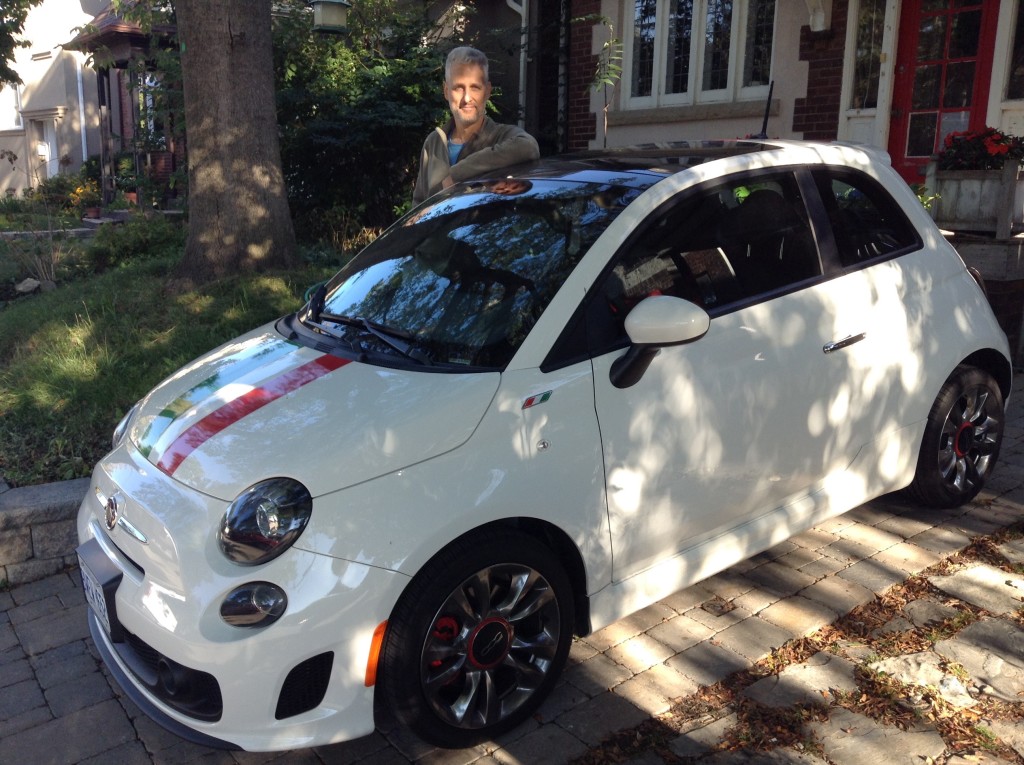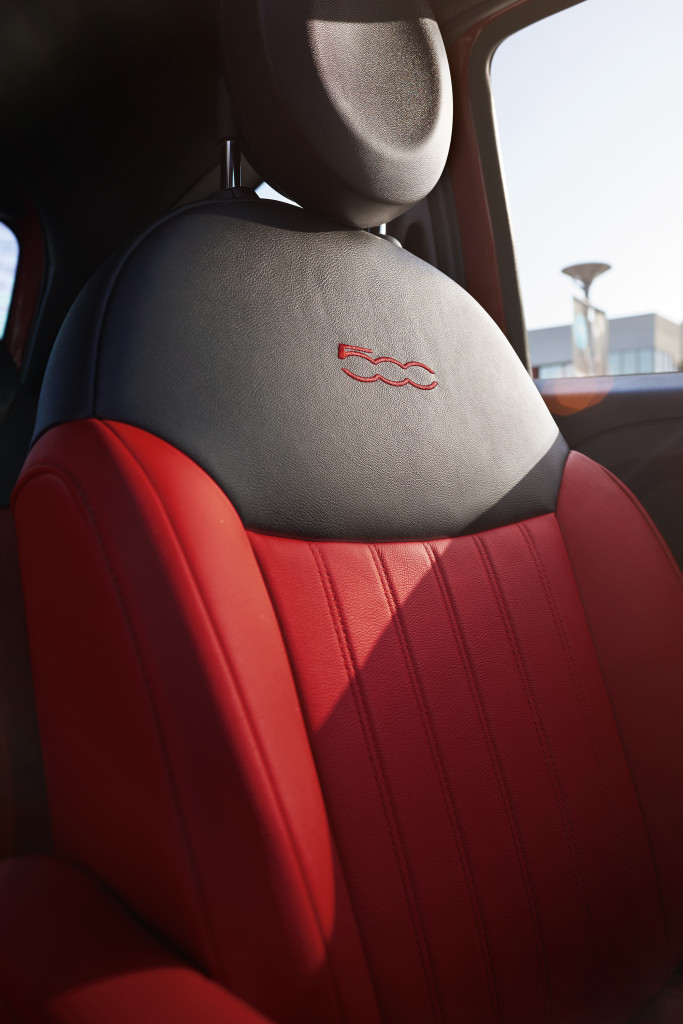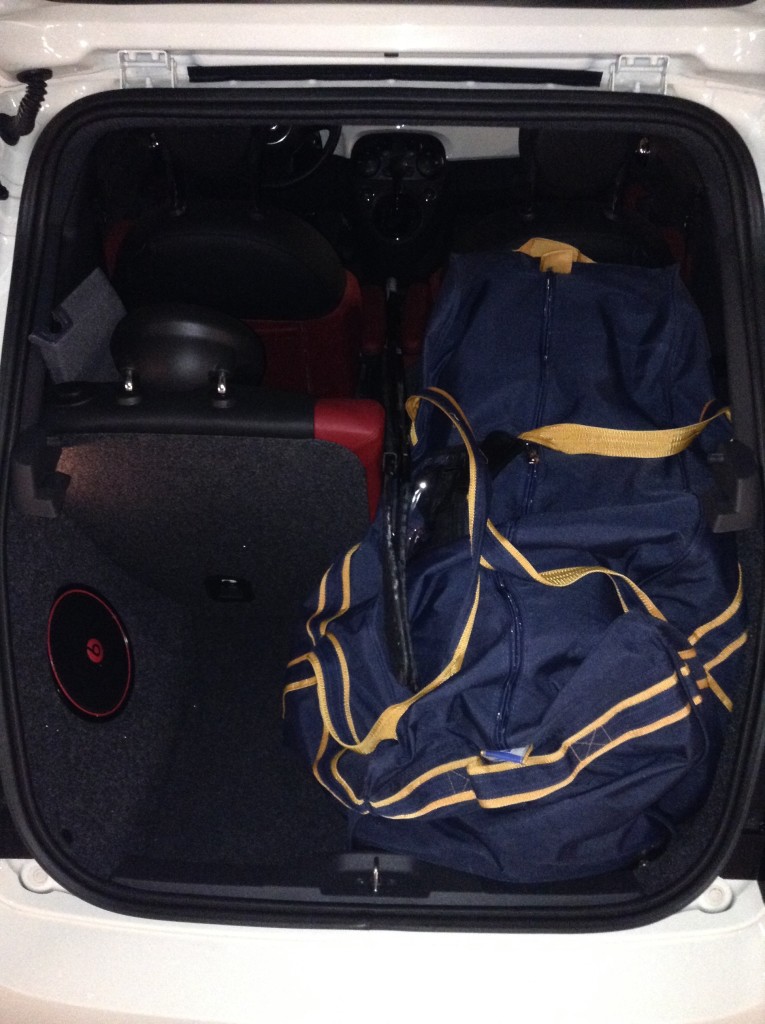Visiting family in Italy both as a child and an adult, I’ve ridden in my share of Fiats. I even drove my aunt’s Punto a couple of times. My cousins may lean towards Lancias and Volkswagens, but our parents favoured Fiats, those economy runabouts made for places where space and gas for cars both come at a premium.
Fast-forward to today, and the Fiat 500, that stalwart of plebeian European motoring, has become an attention-getter on American roads. Fiat Chrysler Automobiles let me reconnect with the brand when it leant me the 2015 Fiat 500 Turbo Hatchback.

First impressions
Much of what made the Fiat the commoner’s car now makes it one of the most distinctive car designs on American roads.
The original 500 was meant to fit the narrow streets of medieval Italian towns. Looking at the car from the front or rear when it’s parked next to larger vehicles, the 500’s narrow stance is obvious.
My tester was a white model sporting “racing stripes” down the centre of the car lengthwise that run in the colours of the Italian flag. For the record, it’s Mopar’s Italian Stripe Package, a $675 extra. That stripe runs the length of the hood, continues on the roof behind the sunroof, works its way over the rear spoiler to end on the hatchback door. The overall effect prompted comparisons to the branding of Brio Chinotto, an Italian soft drink.

To complete the look, Italian flag badges adorn the sides of the car just ahead of the front doors.
The wheels on my tester did not sport the classic “frisbee” hubcaps that match the car’s colour.
An aside: Fiat and Chrysler are in the same company now, so they might want to reexamine their naming conventions. I first noticed the Fiat’s small size several years ago when I drove my dad to pick up a brand-new (and noticeably larger) Chrysler 200 from a dealership near his place. This company goes from the Chrysler 200 to the Chrysler 300 to… the Fiat 500. Just a thought.
Interior
Fewer-than-average seat adjustments will keep tall car buyers away from the Fiat, and this model’s lovely red leather, 500-branded seat (an $850 option).
I couldn’t lower the seat enough to keep my head from being a little jammed against the optional $1,200 power sunroof. That the car is small shouldn’t mean tall people can’t fit inside. I’ve been comfortable in other compact cars. Heck, during family trips to Italy in the ’70s and ’80s, I rode in the back seats of Fiats. (I admit to having been smaller than my current 6’5”.)
I looked at the back seat of this 500. I didn’t try it. But on one trip back from IKEA, we were passed by three people in another 500. I won’t imagine how the third person fit back there.
Reaching back from the front seat, I could almost touch the rear glass. I did touch the housing for the brake light near the roof.
The dash layout was charmingly minimalist, especially with the body-coloured panel on which controls resided.
The only things apparent on the doors were the side-view mirror controls, chrome door handles and two of the six speakers for the Beats Premium Audio System (a $995.00 extra). (Power window switches sit on the centre console to either side of the shift lever, within easy reach of both driver and passenger.)
The door handles reminded me of hand cranks that people once used to open and close windows. They also serve as power door locks. Just press them towards the door to lock, and pull away to unlock. (That’s perfectly logical, since people pull door handles to open them. I like logical design.)
Cargo capacity
I knew from the outset that I wasn’t going to make any heavy-duty IKEA trips in this car, although the 500’s trunk handled grocery trips with little trouble. It’s quite wide at the base, narrowing as it rises to a gap between the rear seats and the hatch. That gap is covered by the narrowest privacy cover I’ve ever seen.
The hockey bag wasn’t going in without one of the 50-50 rear seats going down. One large speaker sits by itself on the left side of the trunk, so I put the bag on the right side. The bag had to suck in its gut to fit. (It would have had an easier time if I had lowered the other seat.) Stick blades sat on top of the other rear seat and the butt ends hovered over the emergency brake lever.
Electronics
At first glance the 500 doesn’t seem like it has many common in-car modern conveniences. There’s no touchscreen. The audio head unit sports what look like typical buttons and little more, surrounding a narrow screen that only displays text. (I’m told next year’s 500 will offer a touch screen option.)
That said, the steering wheel showed buttons enabling phone usage and voice commands. Also, the combination door handle/lock levers hinted at Fiat’s desire to retain the cachet stemming from the simplicity of this car’s ancestor while also adding features expected in today’s vehicles. So I did some exploring. In other words, I pulled the manual out of the glovebox and read it.
As it turns out, appearances were deceiving. This car contains more technology than it shows.
Doing things like setting up Bluetooth devices must be done using voice commands spelled out in the manual. That’s how you start using the 500’s Blue&Me handsfree communication system. (Automakers might use this ploy to encourage more drivers to try voice commands at least once. It might make the roads safer if, as some people argue, greater use of in-car voice commands help drivers keep their eyes on the road and reduce the number of collisions that result from technology-induced driver inattention.)
Just behind the steering wheel, Fiat included a 7-inch round customizable “in-cluster” display, the Electronic Vehicle Information Centre (EVIC). It shows all the typical things you would want to see – revolutions per minute, speed, fuel level, time. Fiat includes an Eco Index as well to tell you how efficiently you’re driving.
The EVIC shows different things depending on context. It displays tracks playing on the audio system. Put the car into reverse and this screen flashes rear park assist (a $375 extra) to warn you of objects in front of or to the side of your rear bumper.
You can change what the screen shows using buttons located to the right of the display. Drivers may want to choose their settings while parked. The buttons sit on the dash behind the steering wheel, making them a little awkward to reach.
Like the Chrysler 200 I reviewed last year, the Fiat sports audio controls behind the steering wheel at the 9 o’clock and 3 o’clock positions. The right-hand (3 o’clock) control raises and lowers the volume, while the left-hand (9 o’clock) control lets the driver skip tracks on whatever media is playing. Buttons on the face of the steering wheel manage cruise control, handsfree phone and voice command switches.
Fiat gives drivers access to a collection of smartphone apps to complement their cars.
Driving
The 500 turns on a dime. That wheels-at-the-corner stance provides the manoeuvrability you need to navigate winding Italian cobblestone roads and tightly packed parking lots alike. You’ll find yourself easily sliding into parking spots that most other drivers write off.
A 1.4L I-4 turbo engine drives the 500. It produces a peak 135 horsepower, plenty to drive this light compact car on the highway. New this model year, power travels through a 6-speed Aisin heavy-duty automatic transmission.
Fuel economy
Fiat publishes city mileage of 9.6 L/100km and highway mileage of 7.3 L/100km.
Pricing
The Fiat 500 Turbo starts at $21,395 MSRP. Optional equipment brought the MSRP of my tester to $30,370.
Conclusions
Here’s the adjective I heard most while I had the 500.
“Cute”
And the looks go beyond the “Brio” racing stripe. The 500 occupies that niche where you’ll find Smart cars, Minis and VW Bugs. These cars stand out because of their shapes. Many businesses choose these cars for their fleets, often applying decals on top of vibrant colours, knowing they’ll be noticed.
You could call the Fiat 500 a fashion accessory on wheels, and you wouldn’t be wrong. It expresses impudent fun even when it stands still. This car turns heads everywhere it goes, frequently evoking smiles from people who see it.
Since reviving the 500, Fiat has built other models using this brand. Fiat appears to want to reestablish itself in North America using past triumphs, retaining the charm of the original 500 as it builds the models it will sell in the future. Judging by the number of 500s on Toronto roads, it looks like they’re making good progress towards that goal.


